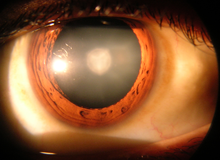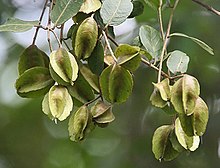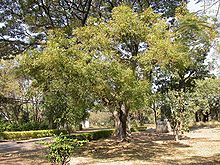Overview
At an early period, Ayurveda adopted the physics of the "five elements" (Devanāgarī: [महा] पञ्चभूत;Pṛthvī- (earth), Jala(water), Agni (fire), Vāyu (air) and Ākāśa(Sky)) — that compose the universe, including the human body.[2] Chyle or plasma (called rasa dhātu), blood (rakta dhātu), flesh (māṃsa]] dhātu), fat (medha dhātu), bone (asthi dhātu), marrow (majja dhātu), and semen or female reproductive tissue (śukra dhātu) are held to be the seven primary constituent elements – saptadhātu (Devanāgarī: सप्तधातु) of the body.[8] Ayurvedic literature deals elaborately with measures of healthful living during the entire span of life and its various phases. Ayurveda stresses a balance of three elemental energies or humors: vāta (air & space – "wind"), pitta (fire & water – "bile") and kapha(water & earth – "phlegm"). According to ayurvedic medical theory, these three substances — doṣas (literally that which deteriorates – Devanāgarī: दोष)—are important for health, because when they exist in equal quantities, the body will be healthy, and when they are not in equal amounts, the body will be be unhealthy in various ways. One ayurvedic theory asserts that each human possesses a unique combination of doṣas that define that person's temperament and characteristics. Another, view, also present in the ancient literature, asserts that humoral equality is identical to health, and that persons with preponderances of humours are proportionately unhealthy, and that this is not their natural temperament. In ayurveda, unlike the Sāṅkhya philosophical system, there are 20 fundamental qualities, guṇa (Devanāgarī: गुण, meaning qualities) inherent in all substances.[9] Surgery and surgical instruments were employed from a very early period,[9] Ayurvedic theory asserts that building a healthy metabolic system, attaining good digestion, and proper excretion leads to vitality.[9] Ayurveda also focuses on exercise, yoga, meditation, and massage.[10]
The practice of pañcakarma (Devanāgarī: पंचकर्म) is a therapeutic regime of purgation, sweating and massage that aims at eliminating toxic elements from the body.[11]
As early as the Mahābhārata, ayurveda was called "the science of eight components" (Skt. aṣṭāṅga, Devanāgarī: अष्टांग), a classification that became canonical for ayurveda. They are:[12]
- Internal medicine (Kāya-cikitsā)
- Paediatrics (Kaumārabhṛtyam)
- Surgery (Śalya-cikitsā)
- Eye and ENT (Śālākya tantra)
- Demonic possession (Bhūta vidyā): Bhūta vidyā has been called psychiatry.[3]
- Toxicology (Agadatantram)
- Prevention diseases and improving immunity and rejuvenation (rasayana)
- Aphrodisiacs and improving health of progeny (Vajikaranam)
In Hindu mythology, the origin of ayurvedic medicine is attributed to the physician of the gods, Dhanvantari.[13]
Practices
Balance
Hinduism and Buddhism have been an influence on the development of many of ayurveda's central ideas — particularly its fascination with balance, known in Buddhism as Madhyamaka (Devanāgarī: माध्यात्मिक).[15] Balance is emphasized; suppressing natural urges is seen to be unhealthy, and doing so may almost certainly lead to illness.[15] However, people are cautioned to stay within the limits of reasonable balance and measure.[15] For example, emphasis is placed on moderation of food intake,[2] sleep, sexual intercourse, and the intake of medicine.[15]
Diagnosis
The Charaka Samhita recommends a tenfold examination of the patient.[16] The qualities to be judged are:[16]
- constitution
- abnormality
- essence
- stability
- body measurements
- diet suitability
- psychic strength
- digestive capacity
- physical fitness
- age
In addition, Chopra (2003) identifies five influential criteria for diagnosis:[16]
- origin of the disease
- prodrominal (precursory) symptoms
- typical symptoms of the fully developed disease
- observing the effect of therapeutic procedures
- the pathological process'
Ayurvedic practitioners approach diagnosis by using all five senses.[16] Hearing is used to observe the condition of breathing and speech.[8] The study of the lethal points or marma is of special importance.[9] Ayurvedic doctors regard physical and mental existence together with personality as a unit, each element having the capacity to influence the others. One of the fundamental aspects of ayurvedic medicine is to take this into account during diagnosis and therapy.
Hygiene
Hygiene is an Indian cultural value and a central practice of ayurvedic medicine.[8] Hygienic living involves regular bathing, cleansing of teeth, skin care, and eye washing.[8] Occasional anointing of the body with oil is also prescribed.[8]
Treatments
Ayurveda stresses the use of plant-based medicines and treatments.[8] Hundreds of plant-based medicines are employed, including cardamom and cinnamon.[8] Some animal products may also be used, for example milk, bones, and gallstones.[8] In addition, fats are used both for consumption and for external use.[8] Minerals, including sulfur,arsenic, lead, copper sulfate and gold are also consumed as prescribed.[8] This practice of adding minerals to herbal medicine is known as rasa shastra.
In some cases, alcohol is used as a narcotic for the patient undergoing an operation.[8] The advent of Islamintroduced opium as a narcotic.[12] Both oil and tar are used to stop bleeding.[8] Traumatic bleeding is said to be stopped by four different methods ligation of the blood vessel; cauterisation by heat; using different herbal or animal preparations locally which facilitate clotting; and different medical preparations which constrict the bleeding or oozing vessels. Different oils may be used in a number of ways including regular consumption as a part of food, anointing, smearing, head massage, and prescribed application to infected areas.[19]
Srotas
Ensuring the proper functions of channels (srotas) that transport fluids from one point to another is a vital goal of ayurvedic medicine, because the lack of healthy srotas is thought to cause rheumatism,epilepsy, autism, paralysis, convulsions, and insanity. Practitioners induce sweating and prescribe steam-based treatments as a means to open up the channels and dilute the doshas that cause the blockages and lead to disease.[20]
History
One view of the early history of ayurveda asserts that around 1500 BC, ayurveda's fundamental and applied principles got organised and enunciated. In this historical construction, Ayurveda traces its origins to the Vedas, Atharvaveda in particular, and is connected to Hindu religion. Atharvaveda (one of the four most ancient books of Indian knowledge, wisdom and culture) contains 114 hymns or formulations for the treatment of diseases. Ayurveda originated in and developed from these hymns. In this sense, ayurveda is considered by some to have divine origin. Indian medicine has a long history, and is one of the oldest organised systems of medicine. Its earliest concepts are set out in the sacred writings called the Vedas, especially in the metrical passages of theAtharvaveda, which may possibly date as far back as the 2nd millennium BC. According to a later writer, the system of medicine was received by Dhanvantarifrom Brahma, and Dhanvantari was deified as the god of medicine. In later times his status was gradually reduced, until he was credited with having been an earthly king [8] named Divodasa.[22]
A different historical narrative been developed by professional historians of medicine during the last twenty years. In this account, the medicine of the Atharvaveda and other Vedas is not directly connected to the origins of Ayurveda, although there are some continuities, especially in the area of pharmacology. The first traces of the ideas that become central to ayurvedic medical theory, such as the theories of doshas (humours) and the classification of disease causes, occur in the Pali Tripitaka, the Buddhist Canon. It has therefore been proposed that ayurvedic theory and practice owes a great deal to the practices and ideas of the ascetic milieu of the fifth to the third centuries BCE. This would include the early Buddhists, the Ajivikas, the Jains, and the ascetics mentioned in the Upanisads, as well as non-denominational renouncers.
Underwood & Rhodes (2008) hold that this early phase of traditional Indian medicine identified 'fever (takman), cough, consumption, diarrhea, dropsy,abscesses, seizures, tumours, and skin diseases (including leprosy)'.[8] Treatment of complex ailments, including angina pectoris, diabetes, hypertension, and stones, also ensued during this period.[6][24] Plastic surgery, cataract surgery, puncturing to release fluids in the abdomen, extraction of foreign elements, treatment of anal fistulas, treating fractures, amputations, cesarean sections, and stitching of wounds were known.[8] The use of herbs and surgical instruments became widespread.[8] The Charaka Samhita text is arguably the principal classic reference. It gives emphasis to the triune nature of each person: body care, mental regulation, and spiritual/consciousness refinement.
Other early works of ayurveda include the Charaka Samhita, attributed to Charaka.[8] The earliest surviving excavated written material which contains references to the works of Sushruta is the Bower Manuscript, dated to the 6th century AD. The Bower manuscript is of special interest to historians due to the presence of Indian medicine and its concepts in Central Asia.[25] Vagbhata, the son of a senior doctor by the name of Simhagupta,[26] also compiled his works on traditional medicine.[8] Early ayurveda had a school of physicians and a school of surgeons.[3] Tradition holds that the text Agnivesh tantra, written by the sage Agnivesh, a student of the sage Bharadwaja, influenced the writings of ayurveda.[27]
The Chinese pilgrim Fa Hsien (ca. 337–422 AD) wrote about the health care system of the Gupta empire (320–550) and described the institutional approach of Indian medicine, also visible in the works of Charaka, who mentions a clinic and how it should be equipped.[28] Madhava (fl. 700), Sarngadhara (fl. 1300), and Bhavamisra (fl. 1500) compiled works on Indian medicine.[25] The medical works of both Sushruta and Charaka were translated into the Arabic languageduring the Abbasid Caliphate (ca. 750).[29] These Arabic works made their way into Europe via intermediaries.[29] In Italy, the Branca family of Sicily and Gaspare Tagliacozzi (Bologna) became familiar with the techniques of Sushruta.[29]
British physicians traveled to India to see rhinoplasty being performed by native methods.[30] Reports on Indian rhinoplasty were published in the Gentleman's Magazine in 1794.[30] Joseph Constantine Carpue spent 20 years in India studying local plastic surgery methods.[30] Carpue was able to perform the first major surgery in the western world in 1815.[31] Instruments described in the Sushruta Samhita were further modified in the Western World.[31]
Current status
Within India
In 1970, the Indian Medical Central Council Act which aims to standardize qualifications for ayurveda and provide accredited institutions for its study and research was passed by the Parliament of India.[32] In India, over 100 colleges offer degrees in traditional ayurvedic medicine.[10] The Indian government supports research and teaching in ayurveda through many channels at both the national and state levels, and helps institutionalize traditional medicine so that it can be studied in major towns and cities.[33] The state-sponsored Central Council for Research in Ayurveda and Siddha (CCRAS) is the premier institution for promotion of traditional medicine in India.[34] The studies conducted by this institution encompass clinical, drug, literary, and family welfare research.[34] To fight biopiracy and unethical patents, the Government of India, in 2001, set up the Traditional Knowledge Digital Library as repository of 1200 formulations of various systems of Indian medicine, such as ayurveda, unani and siddha.[35][36] The library also has 50 traditional ayurveda books digitized and available online.[37]
Central Council of Indian Medicine (CCIM) a statutory body established in 1971, under Department of Ayurveda, Yoga and Naturopathy, Unani, Siddha and Homoeopathy (AYUSH), Ministry of Health and Family Welfare, Government of India, monitors higher education in ayurveda.[38] The Bachelor of Ayurveda, Medicine and Surgery (BAMS) degree is the basic five-and-a-half year course of graduation. It includes eighteen different subjects comprising courses on anatomy with cadaver dissections, physiology, pharmacology, pathology, modern clinical medicine & clinical surgery, pediatrics, along with subjects on ayurveda like Charaka Samhita, history and evolution of ayurveda, identification and usage of herbs (dravyaguna), and ayurvedic philosophy in diagnostics and treatment. post graduation programmes are also available in various specialities in ayurveda including surgery, paediatrics etc. The degree is awarded as m.d (ayurveda vachaspati) and m.s ayurveda (ayurveda dhanvantri). CCIM has also started the post graduation diplomas in various specialities of ayurveda.
Many clinics in urban and rural areas are run by professionals who qualify from these institutes.[32] Mukherjee & Wahile cite World Health Organization statistics to demonstrate the popularity of traditional medicine as the primary system of health care.[39]
Outside India
Academic institutions related to traditional medicine in India have contributed to ayurveda's international visibility.[40] Kurup (2003) comments on the role of Gujarat Ayurved University:[40]
Several international and national initiatives have been formed to legitimize the education and practice of ayurvedic medicine as CAM in countries outside India:
- WHO policy of traditional medicine practice [41] and standardized benchmarks for training of Ayurvedic practitioners [42]
- The European Federation for Complementary and Alternative Medicine[43]
- The European Ayurveda Association[44]
In Sri Lanka
- Institute of Indigenous Medicine affiliated to University of Colombo[45]
- Gampaha Wickramarachchi Ayurveda Institute affiliated to University of Kelaniya[46]
- Ayurveda Lanka Hospital Pvt Ltd.
- Dr Eliyantha White - ayurvedic doctor from Colombo, Sri Lanka.
Due to different laws and medical regulations in the rest of the world, the unregulated practice and commercialization of ayurvedic medicine has raised ethical and legal issues; in some cases, this damages the reputation of ayurvedic medicine outside India.[47][48][49]
In the United States
- The Association of Ayurvedic Professionals of North America (AAPNA)[50]
- The National Ayurvedic Medical Association (NAMA)[51]
- The National Center for Complementary and Alternative Medicine (NCCAM) of the United States National Institutes of Health [52]
- California Association of Ayurvedic Medicine (CAAM)[53]
- The National Institute of Ayurvedic Medicine (NIAM)[54]
- The California College of Ayurveda (CCA)[55]
- The Southern California University of Health Sciences (SCUHS)[56]
Early contributors to the promotion of Ayurveda in the United States include the Maharishi Mahesh Yogi's Transcendental Meditation group along with Dr. Deepak Chopra. Other important early promoters include Dr. David Frawley, Dr. Vasant Lad, Dr. Robert Svoboda Dr. John Douillard, Dr. Sarita Shrestha and Dr. Marc Halpern. In 1995, the California College of Ayurveda became the first State-Approved institution for training practitioners of Ayurveda in the United States marking the beginning of the formalization of Ayurvedic education in the United States. In 1997, Dr. Marc Halpern and several graduates of the California College of Ayurveda formed the California Association of Ayurvedic Medicine. This association was the first State association promoting the interests of Ayurveda in the United States. In 1998, four individuals founded the National Ayurvedic Medical Association. These four individuals were Dr. Marc Halpern, Wynn Werner, Dr. Kumar Batra and Cynthia Copple. In 2009, the United States of America National Center for Complementary and Alternative Medicine (NCCAM) of the National Institutes of Health expended $1.2 million[57] of its $123 million annual budget on ayurvedic medicine-related research.
In the United Kingdom
The British Ayurvedic Medical Council (BAMC) and British Association of Accredited Ayurvedic Practitioners (BAAAP) Ayurveda Practitioners Association (APA)
Ayurveda was introduced to UK in early eighties. In 2001, the Thames Valley University started the first degree qualification in Ayurveda. It was followed by Manipal Ayurvedic University of Europe (BSc- Ayurveda) in 2006 and Middlesex University offering bachelors and masters degree programmes in Ayurveda.
The Secretary of State for Health has announced in a Ministerial Statement issued on 16 February 2011 by the UK Department of Health that the Health Professions Council (HPC) has been asked to establish a statutory register for practitioners supplying unlicensed herbal medicines including Ayurveda.A formal consultation exercise will take place on specific legislative proposals for establishing the register and proposed reforms of medicines legislation later in 2011. Subject to Parliamentary procedures, the Department of Health aims to have the legislation in place in 2012.
Journals
A variety of peer reviewed journals focus on the topic of ayurvedic medicine:
- Ancient Science of Life[58]
- Theoretical and Experimental Journal of Ayurveda and Siddha
- Journal of Research & Education in Indian Medicine (JREIM),[59]
- AYU[60]
- The International Journal for Ayurveda Research (IJAR)[61]
None of the journals except IJAR[62] are PubMed indexed. The first subspeciality journal for the field of ayurvedic medicine was launched in July 2010.[63] Its focus is rheumatology and it is titled the Journal of Clinical Rheumatology in Ayurveda.[64]
Patents
In December 1993, the University of Mississippi Medical Center had a patent issued to them by United States Patent and Trademark Office on the use of turmeric for healing.[65] The patent was contested by India's industrial research organization, Council for Scientific and Industrial Research (CSIR), on the grounds that traditional ayurvedic practitioners were already aware of the healing properties of the substance for centuries, and that this prior art made the patent a case of bio-piracy.[66] The Government of India had become involved in promoting traditional medicine by 1997.[4] R A Mashelkar, director-general of the Indian Council of Scientific and Industrial Research, made the following observation:[67]
This is a significant development of far-reaching consequences for the protection of the traditional knowledge base in the public domain, which has been an emotional issue for not only the people of India but also for the other third world countries.
Scientific evidence
As a traditional medicine, many ayurveda products have not been tested in rigorous scientific studies and clinical trials. In India, research in ayurveda is largely undertaken by the statutory body of the Central Government, the Central Council for Research in Ayurveda and Siddha (CCRAS), through a national network of research institutes.[68] A systematic review of ayurveda treatments for rheumatoid arthritis concluded that there was insufficient evidence, as most of the trials were not done properly, and the one high-quality trial showed no benefits.[69] A review of ayurveda and cardiovascular disease concluded that while the herbal evidence is not yet convincing, the spices are appropriate, some herbs are promising, and yoga is also a promising complementary treatment.[70]
Some ayurvedic products, mainly herbs used for phytotherapy, have been tested with promising results. Studies suggest that Turmeric and its derivativecurcumin are antioxidants.[71][72] Tinspora cordifolia has been tested.[73] Among the medhya rasayanas (intellect rejuvenation), two varieties of Salvia have been tested in small trials; one trial provided evidence that Salvia lavandulifolia (Spanish sage) may improve word recall in young adults,[74] and another provided evidence that Salvia officinalis (Common sage) may improve symptoms in Alzheimer's patients.[75] In some cases, ayurvedic medicine may provide clues to therapeutic compounds. For example, derivatives of snake venom have various therapeutic properties.[76] Many plants used as rasayana (rejuvenation) medications are potent antioxidants.[77]Neem appears to have beneficial pharmacological properties.[78]
Mitra & Rangesh (2003) hold that cardamom and cinnamon stimulate digestive enzymes that break down polymeric macromolecules in the human body.[18] Research suggests that T. arjuna is useful in alleviating the pain of angina pectoris and in treating heart failure and coronary artery disease.[79] T. arjuna may also be useful in treating hypercholesterolemia.[79]
Safety
Rasa shastra, the practice of adding metals, minerals or gems to herbs, is a source of toxic heavy metals such as lead, mercury and arsenic.[82] Adverse reactions to herbs due to their pharmacology are described in traditional ayurvedic texts, but ayurvedic practitioners are reluctant to admit that herbs could be toxic and the reliable information on herbal toxicity is not readily available.[83]
A 2004 study found such toxic metals in 20% of ayurvedic preparations that were made in South Asia for sale around Boston and extrapolated the data to the United States more broadly. It concluded that excess consumption of these products could cause health risks.[84] A 2008 study of more than 230 products found that approximately 20% of remedies (and 40% of rasa shastra medicines) purchased over the Internet from both US and Indian suppliers contained lead, mercury or arsenic.[82][85][86]
Traditionally the toxicity of these materials are believed to be reduced through purification processes such as samskaras or shodhanas (for metals), which is similar to the Chinese pao zhi, although the ayurvedic technique is more complex and may involve prayers as well as physical pharmacy techniques. One medical journal reported:
Crude aconite is an extremely lethal substance, yet ayurveda looks upon it as a therapeutic entity. Crude aconite is always processed, i.e. it undergoes 'samskaras' before being utilised in the ayurvedic formulations. This study was undertaken in mice, to ascertain whether "processed" aconite is less toxic as compared to the crude or unprocessed one. It was seen that crude aconite was significantly toxic to mice (100% mortality at a dose of 2.6 mg/mouse) whereas the fully processed aconite was absolutely non-toxic (no mortality at a dose even 8 times as high as that of crude aconite). Further, all the steps in the processing were essential for complete detoxification.[87][88]
Following concerns about metal toxicity, the Government of India ruled that ayurvedic products must specify their metallic content directly on the labels of the product.[89] The harmful effects of the samples is attributed in part to the adulterated raw material and lack of workers trained in traditional medicine.[90] In a letter to the Indian Academy of Sciences, director of the Interdisciplinary School of Health Sciences, University of Pune Bhushan Patwardhan stated that the metal adulteration is due to contamination and carelessness during the much faster modern manufacturing processes, and does not occur with traditional methods of preparation.[91]
















No comments:
Post a Comment